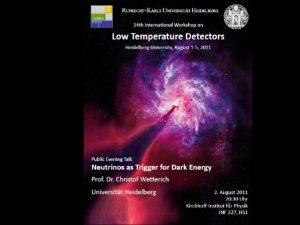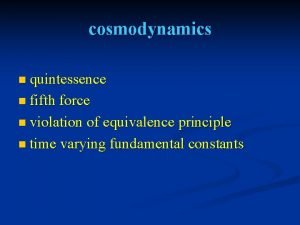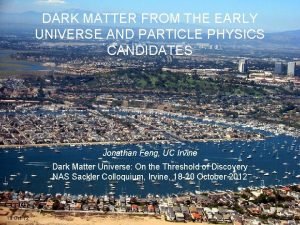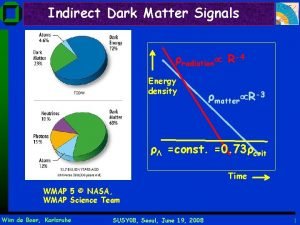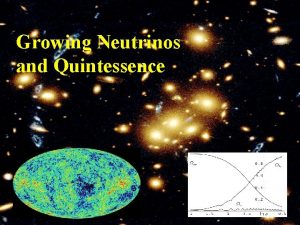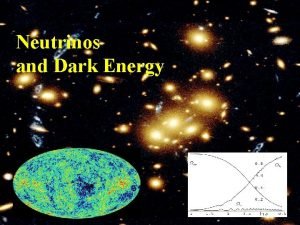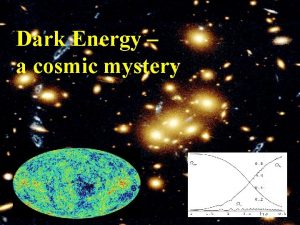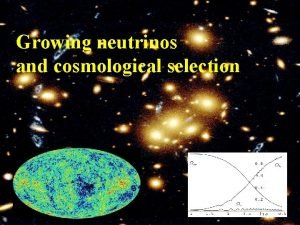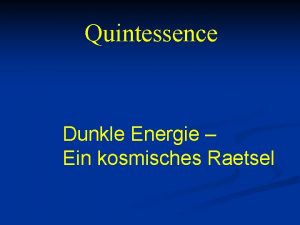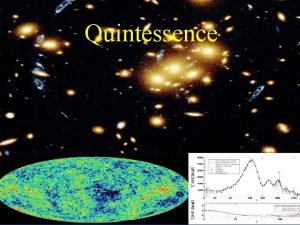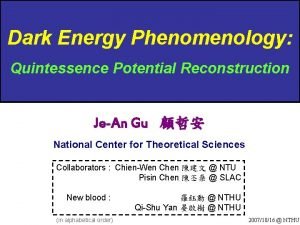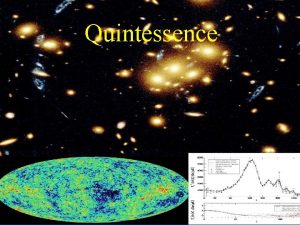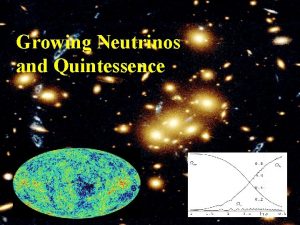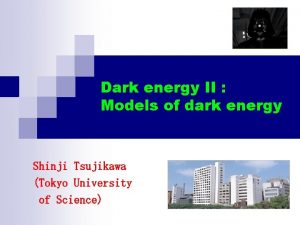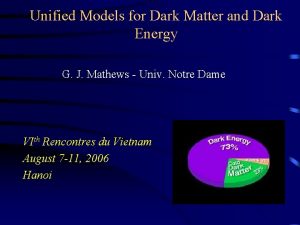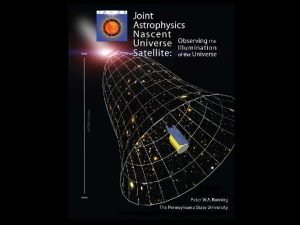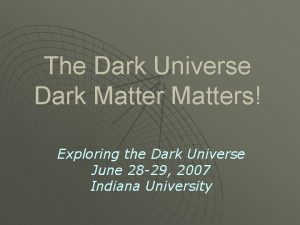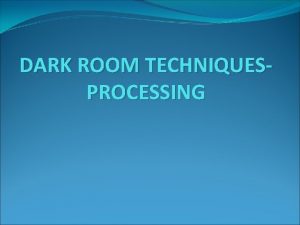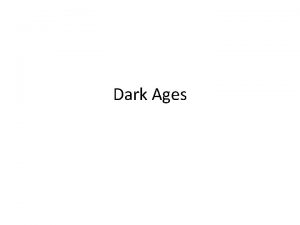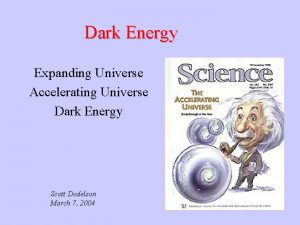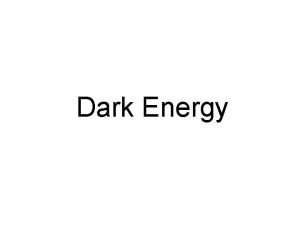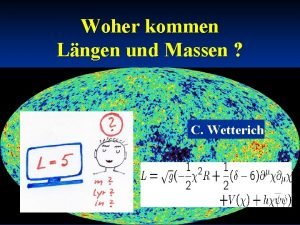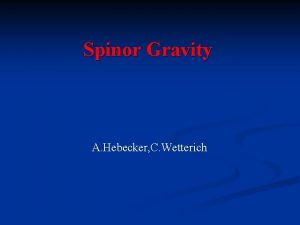Models for Dark Energy Quintessence C Wetterich A














































































- Slides: 78

Models for Dark Energy

Quintessence C. Wetterich A. Hebecker, M. Doran, M. Lilley, J. Schwindt, C. Müller, G. Schäfer, E. Thommes, R. Caldwell, M. Bartelmann, K. Kharwan, G. Robbers, T. Dent, S. Steffen, L. Amendola, M. Baldi

What is our universe made of ? quintessence ! fire , air, water, soil !

Dark Energy dominates the Universe Energy - density in the Universe = Matter + Dark Energy 25 % + 75 %

Ωm= 0. 25 gravitational lens , HST

Ωtot=1

Matter : everything that clumps ----------Dark Energy density is the same at every point of space “ homogeneous “ Space between clumps is not empty

Composition of the Universe Ωb = 0. 045 visible clumping Ωdm= 0. 2 invisible clumping Ωh = 0. 75 invisible homogeneous

What is Dark Energy ? Cosmological Constant or Quintessence ?

Cosmological Constant - Einstein n Constant λ compatible with all symmetries n No time variation in contribution to energy density n Why so small ? λ/M 4 = 10 -120 n Why important just today ?

Cosm. Const. | Quintessence static | dynamical

Cosmological mass scales n Energy density ρ ~ ( 2. 4× 10 -3 e. V )- 4 Reduced Planck mass M=2. 44× 1018 Ge. V n Newton’s constant GN=(8πM²) n Only ratios of mass scales are observable ! homogeneous dark energy: ρh/M 4 = 6. 5 10ˉ¹²¹ matter: ρm/M 4= 3. 5 10ˉ¹²¹

Quintessence Dynamical dark energy , generated by scalar field (cosmon) C. Wetterich, Nucl. Phys. B 302(1988)668, 24. 9. 87 P. J. E. Peebles, B. Ratra, Ap. J. Lett. 325(1988)L 17,

Prediction : homogeneous dark energy influences recent cosmology - of same order as dark matter Original models do not fit the present observations …. modifications

Quintessence Cosmon – Field φ(x, y, z, t) Homogeneous und isotropic Universe : φ(x, y, z, t)=φ(t) Potential und kinetic energy of the cosmon -field contribute to a dynamical energy density of the

Cosmon n Scalar field changes its value even in the present cosmological epoch n Potential und kinetic energy of cosmon contribute to the energy density of the Universe n Time - variable dark energy : ρh(t) decreases with time !

Cosmon n Tiny mass n mc ~H n New long - range interaction

“Fundamental” Interactions Strong, electromagnetic, weak interactions On astronomical length scales: graviton + cosmon gravitation cosmodynamics

Evolution of cosmon field Field equations Potential V(φ) determines details of the model e. g. V(φ) =M 4 exp( - αφ/M ) for increasing φ the potential decreases towards zero !

Cosmic Attractors Solutions independent of initial conditions typically V~t -2 φ ~ ln ( t ) Ωh ~ const. details depend on V(φ) or kinetic term early cosmology

exponential potential constant fraction in dark energy Ωh = 2 n/α can explain order of magnitude of dark energy !

realistic quintessence fraction in dark energy has to increase in “recent time” !

cosmic coincidence

Quintessence becomes important “today” No reason why w should be constant in time !

coincidence problem What is responsible for increase of Ωh for z < 6 ?

a) Properties of cosmon potential or kinetic term Late quintessence n w close to -1 n Ωh negligible in early cosmology n needs tiny parameter, similar to cosmological constant Early quintessence n Ωh changes only modestly n w changes in time transition n special feature in cosmon potential or kinetic term becomes important “now” n tuning at ‰ level

b) Quintessence reacts to some special event in cosmology n Onset of matter dominance K- essence n Appearance of non-linear structure Back-reaction effect Amendariz-Picon, Mukhanov, Steinhardt needs higher derivative kinetic term needs coupling between Dark Matter and Dark Energy

growing neutrino mass triggers transition to almost static dark energy growing neutrino mass L. Amendola, M. Baldi, …

connection between dark energy and neutrino properties present dark energy density given by neutrino mass present equation of state given by neutrino mass !

dark energy fraction determined by neutrino mass constant neutrino - cosmon coupling β variable neutrino - cosmon coupling

basic ingredient : cosmon coupling to neutrinos

Cosmon coupling to atoms Tiny !!! n Substantially weaker than gravity. n Non-universal couplings bounded by tests of equivalence principle. n Universal coupling bounded by tests of Brans. Dicke parameter ω in solar system. n Only very small influence on cosmology. n

Cosmon coupling to Dark Matter Only bounded by cosmology n Substantial coupling possible n Can modify scaling solution and late cosmology n Role in clustering of extended objects ? n L. Amendola

Cosmon coupling to neutrinos n can be large ! Fardon, Nelson, Weiner interesting effects for cosmology if neutrino mass is growing neutrinos can stop the evolution of the cosmon n transition from early scaling solution to cosmological constant dominated cosmology n L. Amendola, M. Baldi, …

growing neutrino mass triggers transition to almost static dark energy growing neutrino mass

cosmological selection n present value of dark energy density set by cosmological event ( neutrinos become non – relativistic ) n not given by ground state properties !

growing neutrinos

end of matter domination n growing mass of neutrinos n at some moment energy density of neutrinos becomes more important than energy density of dark matter n end of matter dominated period similar to transition from radiation domination to matter domination this transition happens in the recent past n n

neutrino mass seesaw and cascade mechanism triplet expectation value ~ doublet squared omit generation structure

cascade mechanism triplet expectation value ~ M. Magg , … G. Lazarides , Q. Shafi , …

varying neutrino mass ε ≈ -0. 05 triplet mass depends on cosmon field φ neutrino mass depends on φ

singular neutrino mass triplet mass vanishes for φ → φt neutrino mass diverges for φ → φt

early scaling solution ( tracker solution ) neutrino mass unimportant in early cosmology

growing neutrinos change cosmon evolution modification of conservation equation for neutrinos

effective stop of cosmon evolution almost stops once n neutrinos get non –relativistic n ß gets large This always happens for φ → φt !

effective cosmological trigger for stop of cosmon evolution : neutrinos get non-relativistic n this happened recently ! n sets scales for dark energy !

effective cosmological constant at late time realistic value for α φt / M ≈ 276

crossover to dark energy dominated universe starts at time when “neutrino force” becomes important for the evolution of the cosmon field

cosmological selection !

cosmon evolution

neutrino fraction remains small Ων mν = 0. 45 e. V z

equation of state present equation of state given by neutrino mass !

oscillating neutrino mass

Hubble parameter as compared to ΛCDM

Hubble parameter ( z < zc ) only small difference from ΛCDM !

How can quintessence be distinguished from a cosmological constant ?

Time dependence of dark energy cosmological constant : Ωh ~ t² ~ (1+z)-3 M. Doran, …

small early and large present dark energy fraction in dark energy has substantially increased since end of structure formation expansion of universe accelerates in present epoch

effects of early dark energy n modifies cosmological evolution (CMB) n slows down the growth of structure

Early quintessence slows down the growth of structure

interpolation of Ωh bounds on Early Dark Energy after WMAP’ 06 G. Robbers, M. Doran, …

bounds on Early Dark Energy after WMAP’ 06 G. Robbers, M. Doran, …

Little Early Dark Energy can make large effect ! Non – linear enhancement Cluster number relative to ΛCDM Two models with 4% Dark Energy during structure formation Fixed σ8 ( normalization dependence ! ) More clusters at high redshift ! Bartelmann, Doran, …

How to distinguish Q from Λ ? A) Measurement Ωh(z) H(z) i) Ωh(z) at the time of structure formation , CMB - emission or nucleosynthesis ii) equation of state wh(today) > -1 B) Time variation of fundamental “constants” C) Apparent violation of equivalence principle D) Possible coupling between Dark Energy and Dark Mater

Cosmodynamics Cosmon mediates new long-range interaction Range : size of the Universe – horizon Strength : weaker than gravity photon electrodynamics graviton gravity cosmon cosmodynamics Small correction to Newton’s law

Quintessence and time variation of fundamental constants Generic prediction Strong, electromagnetic, weak interactions Strength unknown C. Wetterich , Nucl. Phys. B 302, 645(1988 ) gravitation cosmodynamics

Time varying constants It is not difficult to obtain quintessence potentials from higher dimensional or string theories n Exponential form rather generic ( after Weyl scaling) n But most models show too strong time dependence of constants ! n

Are fundamental “constants” time dependent ? Fine structure constant α (electric charge) Ratio electron mass to proton mass Ratio nucleon mass to Planck mass

Quintessence and Time dependence of “fundamental constants” n Fine structure constant depends on value of cosmon field : α(φ) (similar in standard model: couplings depend on value of Higgs scalar field) n Time evolution of φ Time evolution of α Jordan, …

baryons : the matter of stars and humans Ωb = 0. 045

primordial abundances for three GUT models He present observations : 1σ D Li T. Dent, S. Stern, …

three GUT models unification scale ~ Planck scale n 1) All particle physics scales ~ΛQCD n 2) Fermi scale and fermion masses ~ unification scale n 3) Fermi scale varies more rapidly than ΛQCD n Δα/α ≈ 4 10 -4 allowed for GUT 1 and 3 , larger for GUT 2 Δln(Mn/MP) ≈40 Δα/α ≈ 0. 015 allowed

Time variation of coupling constants must be tiny – would be of very high significance ! Possible signal for Quintessence

Summary o Ωh = 0. 75 o Q/Λ : dynamical und static dark energy will be distinguishable o growing neutrino mass can explain why now problem o Q : time varying fundamental coupling “constants” violation of equivalence principle

? ? ? ? ? ? Are dark energy and dark matter related ? Can Quintessence be explained in a fundamental unified theory ?

Quintessence and solution of cosmological constant problem should be related !

End

A few references C. Wetterich , Nucl. Phys. B 302, 668(1988) , received 24. 9. 1987 P. J. E. Peebles, B. Ratra , Astrophys. J. Lett. 325, L 17(1988) , received 20. 1987 B. Ratra, P. J. E. Peebles , Phys. Rev. D 37, 3406(1988) , received 16. 2. 1988 J. Frieman, C. T. Hill, A. Stebbins, I. Waga , Phys. Rev. Lett. 75, 2077(1995) P. Ferreira, M. Joyce , Phys. Rev. Lett. 79, 4740(1997) C. Wetterich , Astron. Astrophys. 301, 321(1995) P. Viana, A. Liddle , Phys. Rev. D 57, 674(1998) E. Copeland, A. Liddle, D. Wands , Phys. Rev. D 57, 4686(1998) R. Caldwell, R. Dave, P. Steinhardt , Phys. Rev. Lett. 80, 1582(1998) P. Steinhardt, L. Wang, I. Zlatev , Phys. Rev. Lett. 82, 896(1999)
 Dark matter and dark energy presentation
Dark matter and dark energy presentation Fire quintessence
Fire quintessence Quintessence force
Quintessence force Quintessence
Quintessence Pater leonhard wetterich
Pater leonhard wetterich Pater leonhard wetterich
Pater leonhard wetterich In the dark dark town
In the dark dark town What is modals and semi modals
What is modals and semi modals Energy energy transfer and general energy analysis
Energy energy transfer and general energy analysis Energy energy transfer and general energy analysis
Energy energy transfer and general energy analysis Cube of stabilized dark energy
Cube of stabilized dark energy Dma dark energy
Dma dark energy Kontinuitetshantering i praktiken
Kontinuitetshantering i praktiken Novell typiska drag
Novell typiska drag Tack för att ni lyssnade bild
Tack för att ni lyssnade bild Ekologiskt fotavtryck
Ekologiskt fotavtryck Varför kallas perioden 1918-1939 för mellankrigstiden?
Varför kallas perioden 1918-1939 för mellankrigstiden? En lathund för arbete med kontinuitetshantering
En lathund för arbete med kontinuitetshantering Särskild löneskatt för pensionskostnader
Särskild löneskatt för pensionskostnader Vilotidsbok
Vilotidsbok Sura för anatom
Sura för anatom Vad är densitet
Vad är densitet Datorkunskap för nybörjare
Datorkunskap för nybörjare Stig kerman
Stig kerman Mall debattartikel
Mall debattartikel Magnetsjukhus
Magnetsjukhus Nyckelkompetenser för livslångt lärande
Nyckelkompetenser för livslångt lärande Påbyggnader för flakfordon
Påbyggnader för flakfordon Tryck formel
Tryck formel Publik sektor
Publik sektor Jag har nigit för nymånens skära
Jag har nigit för nymånens skära Presentera för publik crossboss
Presentera för publik crossboss Teckenspråk minoritetsspråk argument
Teckenspråk minoritetsspråk argument Vem räknas som jude
Vem räknas som jude Klassificeringsstruktur för kommunala verksamheter
Klassificeringsstruktur för kommunala verksamheter Epiteltyper
Epiteltyper Claes martinsson
Claes martinsson Cks
Cks Byggprocessen steg för steg
Byggprocessen steg för steg Mat för unga idrottare
Mat för unga idrottare Verktyg för automatisering av utbetalningar
Verktyg för automatisering av utbetalningar Rutin för avvikelsehantering
Rutin för avvikelsehantering Smärtskolan kunskap för livet
Smärtskolan kunskap för livet Ministerstyre för och nackdelar
Ministerstyre för och nackdelar Tack för att ni har lyssnat
Tack för att ni har lyssnat Referatmarkeringar
Referatmarkeringar Redogör för vad psykologi är
Redogör för vad psykologi är Matematisk modellering eksempel
Matematisk modellering eksempel Atmosfr
Atmosfr Borra hål för knoppar
Borra hål för knoppar Orubbliga rättigheter
Orubbliga rättigheter Standardavvikelse
Standardavvikelse Tack för att ni har lyssnat
Tack för att ni har lyssnat Steg för steg rita
Steg för steg rita Vad är verksamhetsanalys
Vad är verksamhetsanalys Tobinskatten för och nackdelar
Tobinskatten för och nackdelar Toppslätskivling effekt
Toppslätskivling effekt Datumr
Datumr Egg för emanuel
Egg för emanuel Elektronik för barn
Elektronik för barn Antika plagg
Antika plagg Strategi för svensk viltförvaltning
Strategi för svensk viltförvaltning Var 1721 för stormaktssverige
Var 1721 för stormaktssverige Indikation för kejsarsnitt på moderns önskan
Indikation för kejsarsnitt på moderns önskan Sju för caesar
Sju för caesar Tack för att ni lyssnade
Tack för att ni lyssnade Samlade siffror för tryck
Samlade siffror för tryck Dikt fri form
Dikt fri form Inköpsprocessen steg för steg
Inköpsprocessen steg för steg Rbk mätning
Rbk mätning Ledarskapsteorier
Ledarskapsteorier Aktiv exspektans
Aktiv exspektans Myndigheten för delaktighet
Myndigheten för delaktighet Frgar
Frgar Sju principer för tillitsbaserad styrning
Sju principer för tillitsbaserad styrning Läkarutlåtande för livränta
Läkarutlåtande för livränta Karttecken brant
Karttecken brant Lek med former i förskolan
Lek med former i förskolan Vishnuiter
Vishnuiter

